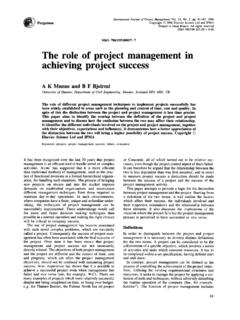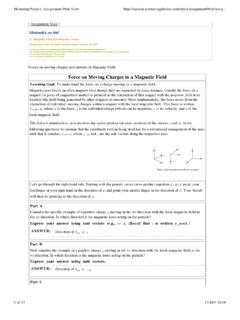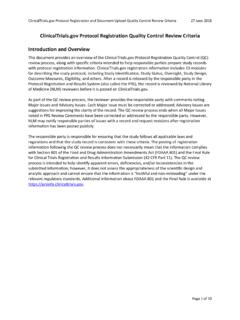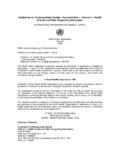Transcription of Project management: cost, time and quality, two best ...
1 Project management: cost, time andquality, two best guesses and aphenomenon, its time to accept othersuccess criteriaRoger AtkinsonDepartment of Information Systems, The Business School, Bournemouth University, Talbot Campus, FernBarrow, Poole, Dorset BH12 5BB, UKThis paper provides some thoughts about success criteria for IS IT Project management. cost, time and quality (The Iron Triangle), over the last 50 years have become inextricably linked withmeasuring the success of Project management. This is perhaps not surprising, since over the sameperiod those criteria are usually included in the description of Project management.
2 Time andcosts are at best, only guesses, calculated at a time when least is known about the Project . Qual-ity is a phenomenon, it is an emergent property of peoples di erent attitudes and beliefs, whichoften change over the development life-cycle of a Project . Why has Project management been soreluctant to adopt other criteria in addition to the Iron Triangle, such as stakeholder bene tsagainst which projects can be assessed? This paper proposes a new framework to consider successcriteria, The Square Route.#1999 Elsevier Science Ltd and IPMA. All rights reservedKeywords: Project management, success criteriaResearch studies investigating the reasons why projectsfail, for example Morris and Hough1and Gallagher,2provide lists of factors believed to contribute to theproject management success or failure.
3 At the sametime some criteria against which projects can bemeasured are available, for example cost, time andquality often referred to as The Iron Triangle,Figure however continue to be described as failing,despite the management. Why should this be if boththe factors and the criteria for success are believed tobe known? One argument could be that Project man-agement seems keen to adopt new factors to achievesuccess, such as methodologies, tools, knowledge andskills, but continues to measure or judge Project man-agement using tried and failed criteria . If the criteriawere the cause of reported failure, continuing to usethose same criteria will simply repeat the failures ofthe past.
4 Could it be the reason some Project manage-ment is labelled as having failed results from the cri-teria used as a measure of success? The questions thenbecome: what criteria are used and what other criteriacould be used to measure success? This paper takes alook at existing criteria against which Project manage-ment is measured and proposes a new way to considersuccess criteria , called the Square paper has four sections. First, existing de -nitions of Project management are reviewed, indicatingThe Iron Triangle success criteria to be almost inex-tricably linked with those de nitions. Next, an argu-ment for considering other success criteria is putforward, separating these into some things which aredone wrong and other things which have been missedor not done as well as they could have done.
5 In thethird section, other success criteria , proposed in the lit-erature is reviewed. Finally The Iron Triangle andother success criteria are placed into one of four majorcategories, this is represented as The Square a reminder about how Project management isde ned, the thing we are trying to is Project management?Many have attempted to de ne Project example, Oisen,3referencing views from the1950's, may have been one of the early Management is the application of a collection oftools and techniques (such as the CPM and matrix or-ganisation) to direct the use of diverse resources towardthe accomplishment of a unique, complex, one-timetask within time, cost and quality constraints.
6 Each taskrequires a particular mix of theses tools and techniquesstructured to t the task environment and life cycle(from conception to completion) of the Journal of Project ManagementVol. 17, No. 6, pp. 337 342, 1999#1999 Elsevier Science Ltd and IPMA. All rights reservedPrinted in Great Britain0263-7863/99 $ + : S0263-7863(98)00069-6337 Notice in the de nition are included some the suc-cess criteria , The Iron Triangle. Those criteria formeasuring success included in the description used byOisen3continue to be used to describe Project manage-ment today. The British Standard for Project manage-ment BS607941996 de ned Project management as:The planning, monitoring and control of all aspects ofa Project and the motivation of all those involved in itto achieve the Project objectives on time and to thespeci ed cost, quality and UK Association of Project Management (APM)have produced a UK Body of Knowledge UK (BoK)5which also provides a de nition for Project manage-ment as.
7 The planning, organisation, monitoring and control ofall aspects of a Project and the motivation of allinvolved to achieve the Project objectives safely andwithin agreed time, cost and performance criteria . Theproject manager is the single point of responsibility forachieving de nitions have been o ered, Reiss6suggestsa Project isa human activity that achieves a clear objec-tive against a time scale,and to achieve this whilepointing out that a simple description is not possible,suggests Project management is a combination of man-agement and planning and the management of 's7view was that Project management hadevolved in order to plan, co-ordinate and control thecomplex and diverse activities of modern industrialand commercial projects.
8 While Burke8considers pro-ject management to be a specialised management tech-nique, to plan and control projects under a strongsingle point of some di erent suggestions about what is pro-ject management have been made, the criteria for suc-cess, namely cost, time and quality remain and areincluded in the actual description. Could this meanthat the example given to de ne Project managementOisen3was either correct, or as a discipline, projectmanagement has not really changed or developed thesuccess measurement criteria in almost 50 management is a learning profession. Basedupon past mistakes and believed best practice, stan-dards such as BS 60794and the UK Body ofKnowledge5continue to be developed.
9 But de ningproject management is di cult, Wirth,9indicated thedi erences in content between six countries own ver-sions of BoK's. Turner10provided a consolidatedmatrix to help understand and moderate di erentattempts to describe Project management, includingthe assessment. Turner10further suggested that projectmanagement could be described as:the art and scienceof converting vision into the criteriaagainst which Project management is measured is notincluded in that description. Is there a paradox how-ever in even attempting to de ne Project management?Can a subject which deals with aunique, one-o com-plex taskas suggested as early as Oisen3be de ned?
10 Perhaps Project management is simply an evolvingphenomena, which will remain vague enough to benon-de nable, a exible attribute which could be astrength. The signi cant point is that while the factorshave developed and been adopted, changes to the suc-cess criteria have been suggested but the link be, that Project management con-tinues to fail because, included in the de nition are alimited set of criteria for measuring success, cost, timeand quality , which even if these criteria are achievedsimply demonstrate the chance of matching two bestguesses and a phenomena to some undergraduate lectures and workshopsabout Project management.















